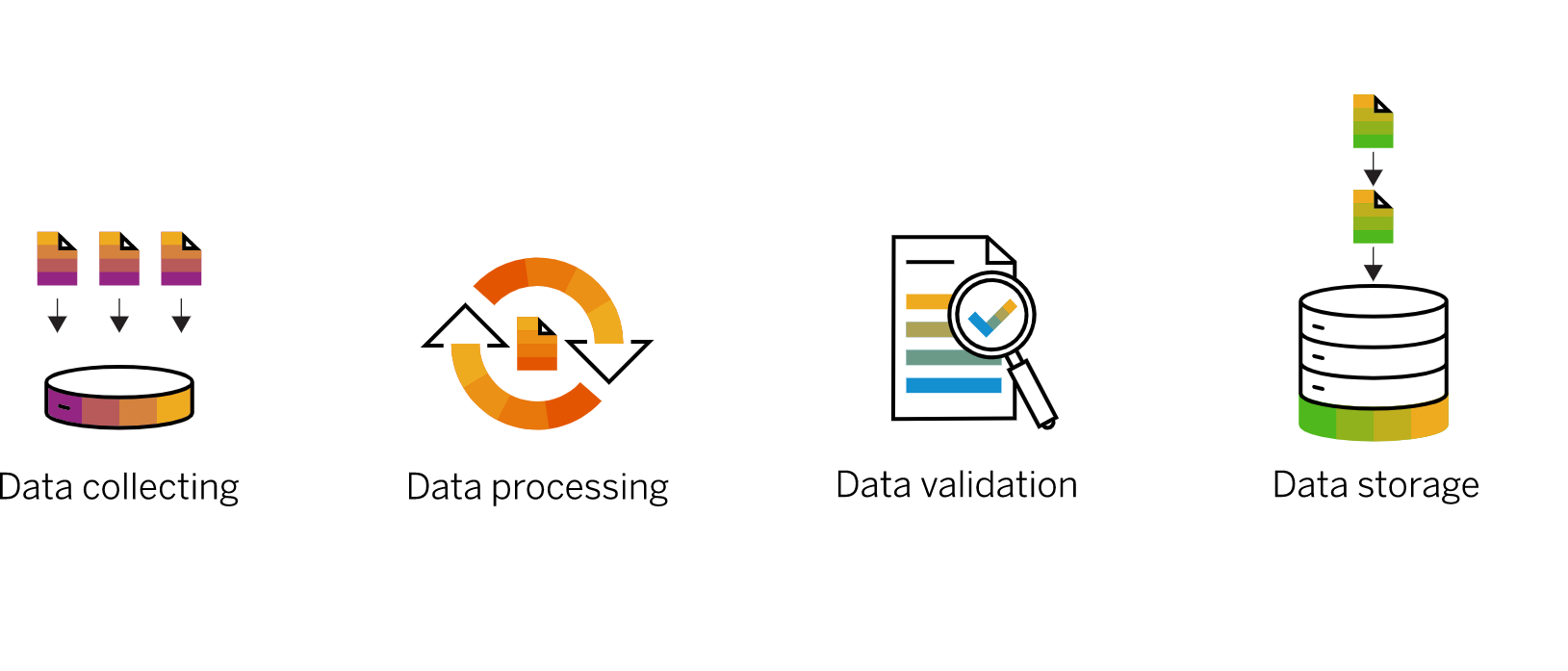¿Qué es la gestión de datos?
Contenido
- Gestión de datos
- Los elementos clave de la gestión de datos
- ¿Por qué es importante la gestión de datos?
- Convertir Big Data en un activo de negocio de alto valor
- Sentar el cimiento de los datos para la transformación digital
- Garantizar el cumplimiento de las leyes de privacidad de datos
- Sistemas y componentes de la gestión de datos
- Sistemas para gestión de bases de datos (DBMS)
- Diferentes sistemas para gestión de datos
- Almacenes y lagos de datos
- Gestión de datos maestros (MDM)
- Gestión de Big Data
- Integración de datos
- Gobernanza, seguridad y cumplimiento de datos
- Business intelligence y analíticas
- ¿Qué es una estrategia empresarial de datos, y por qué debería tener una?
- La evolución de la gestión de datos
- Resumen
Gestión de datos
Los datos son esenciales para las operaciones y el funcionamiento de una empresa. Las empresas deben dar sentido a los datos y encontrar los relevantes entre el ruido creado por los diversos sistemas y tecnologías que dan soporte a las economías globales altamente conectadas de hoy. En este sentido, los datos ocupan un lugar central. Por sí solos, los datos son inútiles –las empresas necesitan una estrategia, gobernanza y un modelo gestión de datos eficaces para aprovechar todas las formas de datos con un uso práctico y eficiente en las cadenas de suministro, redes de empleados, ecosistemas de clientes y socios… y mucho más–
Entonces, ¿qué es la gestión de datos? Es la práctica de recopilar, organizar y acceder a los datos para dar soporte a la productividad, eficiencia y toma de decisiones. Dado el papel fundamental que hoy juegan los datos en los negocios, una estrategia de gestión de datos sólida y un sistema de gestión de datos moderno son esenciales para todas las empresas –independientemente del tamaño o la industria–.

Los elementos clave de la gestión de datos
El proceso de gestión de datos incluye una amplia gama de tareas y procedimientos, tales como:
-
Recopilar, procesar, validar y almacenar datos
-
Integrar diferentes tipos de datos de fuentes dispares, incluyendo datos estructurados y no estructurados
-
Garantizar una alta disponibilidad de datos y su recuperación ante desastres
-
Controlar el modo en que las personas y las apps usan y acceden a los datos
-
Proteger y asegurar los datos y garantizar su privacidad
¿Por qué es importante la gestión de datos?
Cada aplicación, solución analítica y algoritmo (las reglas y procesos que permiten que las computadoras resuelvan problemas y completen tareas) que se usa en una empresa depende de un acceso fluido a los datos. En esencia, un sistema de gestión de datos ayuda a garantizar que sean seguros, accesibles y precisos. Pero los beneficios de la gestión de datos no terminan ahí.
64.2 zettabytes
de datos digitales creados en 2020 – IDC
80 %
de los datos mundiales serán no estructurados en 2025 – IDC
Convertir Big Data en un activo de negocio de alto valor
Demasiados datos pueden resultar abrumadores –e inútiles– si no se gestionan correctamente. Pero con las herramientas adecuadas, Big Data puede aprovecharse para empoderar a las empresas con información estratégica más profunda y proyecciones más precisas. Puede aportar a las empresas una mejor comprensión de lo que desean los clientes, y ayudarlas a brindar experiencias excepcionales en base a los datos que brinda. O a impulsar nuevos modelos de negocio basados en datos –como servicios basados en internet de las cosas (IoT) y datos de sensores en tiempo real– que no serían evidentes ni obvios sin la capacidad de analizar e interpretar Big Data.
Big Data son data sets extremadamente grandes que suelen caracterizarse por las cinco V: volumen, variedad, velocidad, veracidad y valor.
No es ningún secreto que las organizaciones impulsadas por datos tienen una ventaja competitiva importante. Con herramientas avanzadas, las empresas pueden gestionar más datos provenientes de más fuentes que nunca. También pueden aprovechar en tiempo real muchos tipos de datos, estructurados y no estructurados – incluso datos de dispositivos de IoT, archivos de video y audio, de secuencias de clics en internet, y comentarios en redes sociales–, lo cual genera más oportunidades para monetizarlos y usarlos como un activo.
Sentar el cimiento de los datos para la transformación digital
A menudo se dice que los datos son el alma de la transformación digital –y es cierto–. Inteligencia artificial (IA), machine learning, Industria 4.0, analíticas avanzadas, internet de las cosas y automatización inteligente requieren muchos datos oportunos, precisos y seguros para hacer lo que hacen.
La importancia de los datos y de las tecnologías basadas en datos no ha hecho sino aumentar desde el brote de COVID-19. Muchas empresas están sintiendo una intensa presión para usar mejor sus datos ahora –para proyectar eventos futuros, pivotar rápido, y generar resiliencia dentro de planes y modelos de negocio–.
El machine learning, por ejemplo, necesita data sets muy grandes y diversos para «aprender», identificar patrones complejos, resolver problemas, y mantener sus modelos y algoritmos actualizados y funcionando de manera eficaz. Las analíticas avanzadas (que a menudo aprovechan machine learning) también dependen de grandes cantidades de datos de alta calidad para producir información estratégica relevante y accionable sobre la que se pueda actuar con confianza. IoT e IoT industrial operan en un flujo constante de datos provenientes de máquinas y sensores, a un millón de millas por minuto.
El denominador común en cualquier proyecto de transformación digital son los datos. Antes de que las empresas puedan transformar los procesos, aprovechar las nuevas tecnologías y convertirse en empresas inteligentes, necesitan un cimiento de datos sólido. En resumen, necesitan un sistema de gestión de datos moderno.
La supervivencia continua de cualquier negocio dependerá de una arquitectura ágil y centrada en los datos que responda al constante ritmo de cambio.
Donald Feinberg, Vice President de Gartner
Garantizar el cumplimiento de las leyes de privacidad de datos
Una buena gestión de datos también es esencial para garantizar el cumplimiento de las leyes de privacidad de datos nacionales e internacionales –como el Reglamento General de Protección de Datos (RGPD) europeo y la California Consumer Privacy Act en EE. UU.–, así como los requisitos de privacidad y seguridad específicos de la industria. Y cuando esas protecciones deben ponerse a prueba o auditarse, es esencial contar con sólidos procedimientos y políticas de gestión de datos.
Sistemas y componentes de la gestión de datos
Los sistemas para gestión de datos se construyen sobre plataformas dedicadas e incluyen componentes y procesos que trabajan juntos para ayudar a extraer valor de sus datos. Estos pueden incluir sistemas de gestión de bases de datos, almacenes y lagos de datos, integración de datos, analíticas y más.
Sistemas para gestión de bases de datos (DBMS)
Existen muchos tipos diferentes de sistemas para gestión de bases de datos. Los más comunes incluyen sistemas para gestión de bases de datos relacionales (RDBMS), de datos orientados a objetos (OODMBS), in-memory y en columnas.
Diferentes sistemas para gestión de datos
-
Sistema de gestión de bases de datos relacionales (RDBMS): un RDBMS contiene definiciones de datos para que los programas y sistemas de recuperación puedan hacer referencia a ellos por nombre, en lugar de describir su estructura y ubicación cada vez. Según el modelo relacional, los sistemas de RDBMS también mantienen las relaciones entre datos que mejoran el acceso y evitan la duplicación. La definición básica y características de un artículo, por ejemplo, se almacenan una sola vez y se vinculan al detalle y las listas de precios del pedido del cliente.
-
Sistema de gestión de bases de datos orientado a objetos (OODBMS): un OODBMS es un enfoque diferente de la definición y almacenamiento de datos, desarrollado y usado por desarrolladores de sistemas de programación orientados a objetos (OOPS). Los datos se almacenan como objetos, entidades autónomas y autodescritas, en lugar de usar tablas como en un SGBDR.
-
Base de datos in-memory: una IMDB almacena datos en la memoria principal de una computadora (RAM), en lugar de usar una unidad de disco. La recuperación in-memory es mucho más rápida que la recuperación desde un disco, así que las bases de datos in-memory son muy usadas en aplicaciones que requieren una respuesta rápida. Por ejemplo, los informes que alguna vez demoran días en compilarse, ahora se pueden obtener y analizar en minutos, incluso segundos.
-
Base de datos columnar: este tipo almacena juntos los grupos de datos relacionados (una «columna» de información) para tener acceso rápido. Se usa en aplicaciones in-memory modernas y para muchas aplicaciones de almacenamiento de datos independientes donde la velocidad de recuperación (de un rango limitado de datos) es importante.
Almacenes y lagos de datos
-
Almacén de datos: es un repositorio central acumulado desde muchas fuentes distintas con propósitos de informe y análisis.
-
Lago de datos: es una vasta reserva de datos almacenados en su formato crudo o natural. Los lagos de datos se usan habitualmente para almacenar Big Data, incluyendo datos estructurados, no estructurados y semiestructurados.
Gestión de datos maestros (MDM)
La gestión de datos maestros es la disciplina de crear una referencia confiable (una única versión de la verdad) para los datos de negocio importantes, tales como los de productos, clientes, activos, financieros, y más. La MDM ayuda a garantizar que las empresas no usen múltiples versiones de datos potencialmente inconsistentes en diferentes partes del negocio, incluyendo procesos, operaciones, analíticas e informes. Los tres pilares clave para una MDM eficaz incluyen: consolidación, control y gestión de calidad de los datos.
Una disciplina habilitada por la tecnología, donde el negocio y la organización de TI trabajan juntos para garantizar la uniformidad, precisión, administración, consistencia semántica y responsabilidad sobre los activos de datos maestros oficiales compartidos en la empresa.
definición de MDM
Gestión de Big Data
Se han desarrollado nuevos tipos de bases de datos y herramientas para gestionar Big Data –los enormes volúmenes de datos estructurados, no estructurados y semiestructurados que hoy inundan a las empresas–. Además de técnicas de procesamiento altamente eficientes e instalaciones basadas en la nube para manejar volumen y velocidad, se han creado nuevos enfoques para interpretar y gestionar la variedad de los datos. Para que las herramientas de gestión de datos puedan comprender y trabajar con datos no estructurados, por ejemplo, se usan nuevos procesos de preprocesamiento para identificar y clasificar los datos y así facilitar el almacenamiento y la recuperación.
Integración de datos
La integración de datos es la práctica de ingerir, transformar, combinar y brindar datos, donde y cuando se necesiten. Esta integración se lleva a cabo en la empresa y más allá –tanto entre socios como con fuentes de datos y casos de uso de terceros– para cumplir con los requisitos de todas las aplicaciones y procesos del negocio. Las técnicas incluyen, entre otros, movimiento en masa/por lotes, extracción, transformación, carga (ETL), captura de cambios, réplica, virtualización, orquestación e integración de datos.
Gobernanza, seguridad y cumplimiento de datos
es una recopilación de reglas y responsabilidades para garantizar la disponibilidad, calidad, cumplimiento y seguridad de los datos en toda la organización. La gobernanza de datos establece la infraestructura y nombra a las personas (o cargos) dentro de una organización que tendrán la autoridad y responsabilidad de gestionar y salvaguardar clases y tipos de datos específicos. La gobernanza de datos es una parte clave del cumplimiento. Los sistemas se encargarán de la mecánica de almacenamiento, manejo y seguridad –es el lado de las personas, de la gobernanza, el que garantiza que los datos sean precisos desde un inicio y que se manejen y protejan adecuadamente antes de ingresarlos en el sistema, mientras se usan, y cuando se recuperan del sistema para usarlos o almacenarlos otro lugar. La gobernanza especifica cómo las personas responsables deben usar los procesos y tecnologías para gestionar y proteger los datos.
Por supuesto, la es una preocupación importante en el actual mundo de hackers, virus, ciberataques y violaciones de datos. Si bien la seguridad está incorporada dentro de los sistemas y aplicaciones, la gobernanza de datos se aplica para garantizar que estén correctamente configurados y administrados cuando están fuera de los sistemas, y para cumplir con los procedimientos y responsabilidades.
Business intelligence y analíticas
La mayoría, si no todos, los sistemas para gestión de datos incluyen herramientas básicas de recuperación e informes, y muchos incorporan o están agrupados con potentes aplicaciones de recuperación, análisis e informes. Las aplicaciones de informes y también son ofrecidas por desarrolladores externos, y seguramente se incluirán en el paquete de aplicaciones como una función estándar o un módulo adicional opcional avanzado.
El poder de los sistemas para gestión de datos actuales reside, en gran medida, en las herramientas de recuperación ad hoc que permiten que usuarios con una capacitación mínima creen sus propias consultas de datos en pantalla o impresas con una flexibilidad sorprendente de formatos, cálculos, tipos y resúmenes. Además, los profesionales pueden usar estas mismas herramientas u otras analíticas más sofisticadas para hacer aun más cálculos, comparaciones, matemática avanzada y formatos. Las nuevas aplicaciones analíticas son capaces de conectar bases de datos tradicionales, almacenes de datos y lagos de datos para permitir la incorporación de Big Data a fin de una lograr mejor proyección, análisis y planificación.
¿Qué es una estrategia empresarial de datos, y por qué debería tener una?
Muchas empresas han sido pasivas en el enfoque de su estrategia de datos, aceptando lo que su proveedor haya incorporado a sus sistemas. Pero ahora eso no es suficiente. Con la actual explosión de datos y su importancia para el funcionamiento de todas las empresas, es cada vez más necesario adoptar un enfoque más proactivo e integral para la gestión de datos. Desde un punto de vista práctico, eso significa establecer una estrategia de datos que:
-
Identifique el tipo de datos específicos que su empresa necesitará y usará
-
Asigne responsabilidades para cada tipo de datos
-
Establezca procedimientos para controlar la adquisición, recopilación y tratamiento de los datos
Uno de los beneficios clave de una estrategia e infraestructura para gestión de datos es que unifica a la organización –coordinando todas las actividades y decisiones para dar soporte al propósito de la empresa, que es brindar productos y servicios de calidad de manera efectiva y eficiente–. Tener una estrategia de datos integral y una integración de datos fluida elimina los silos de información. Esto permite que cada departamento, gerente y empleado vea y comprenda su contribución individual al éxito de la empresa, y mantenga sus decisiones y acciones alineadas con esos objetivos.
La evolución de la gestión de datos
Una gestión de datos eficaz es crítica para el éxito del negocio desde hace más de 50 años –desde ayudar a las empresas a mejorar la precisión de los informes, hasta detectar tendencias y tomar mejores decisiones para impulsar la transformación digital y potenciar hoy nuevas tecnologías y modelos de negocio–. Los datos se han convertido en un nuevo tipo de capital, y las organizaciones con visión de futuro siempre están buscando nuevas y mejores formas de usarlos en su beneficio. Estas son las últimas tendencias en gestión de datos moderna que se deben vigilar y explorar:
-
Tejido de datos: la mayoría de las organizaciones hoy tienen datos implementados on-premise y en la nube –y usan múltiples sistemas de gestión de bases de datos, tecnologías de procesamiento, y herramientas–. Un tejido de datos, que es una combinación personalizada de arquitectura y tecnología, usa integración y orquestación de datos dinámicas para permitir el acceso e intercambio de datos sin fricciones en un entorno distribuido.
-
Gestión de datos en la nube: muchas empresas están trasladando a la nube algunas o todas sus plataformas para gestión de datos. La gestión de datos en la nube aprovecha todos los beneficios que ofrece la nube –escalabilidad, seguridad avanzada, acceso mejorado, copias de seguridad automatizadas, recuperación ante desastres, ahorro de costos, y más–. Las bases de datos en la nube y las soluciones de base de datos como servicio (DBaaS), los almacenes de datos en la nube y los lagos de datos en la nube están creciendo en popularidad.
-
Gestión de datos aumentada: esta es una de las tendencias más recientes. Señalada por Gartner como una potencial disrupción significativa para 2022, la gestión de datos aumentada usa IA y machine learning para hacer que los procesos de gestión de datos se configuren y ajusten automáticamente. La gestión de datos aumentada está automatizando todo, desde la calidad y la gestión de datos maestros hasta la integración de datos, liberando personal técnico calificado para que se enfoque en generar mayor valor.
En 2022, las tareas manuales de gestión de datos se reducirán en un 45% mediante la adición de machine learning y gestión automatizada del nivel de servicio
-
Analíticas aumentadas: las analíticas aumentadas –otra tendencia tecnológica principal identificada por Gartner – ya están aquí. Las analíticas aumentadas usan inteligencia artificial, machine learning y procesamiento de lenguaje natural (NLP) no solo para encontrar la información estratégica más importante automáticamente, sino para democratizar el acceso a analíticas avanzadas, de modo que todos, no solo los científicos de datos, puedan hacer preguntas sobre sus datos y obtener respuestas de una manera natural y conversacional.




